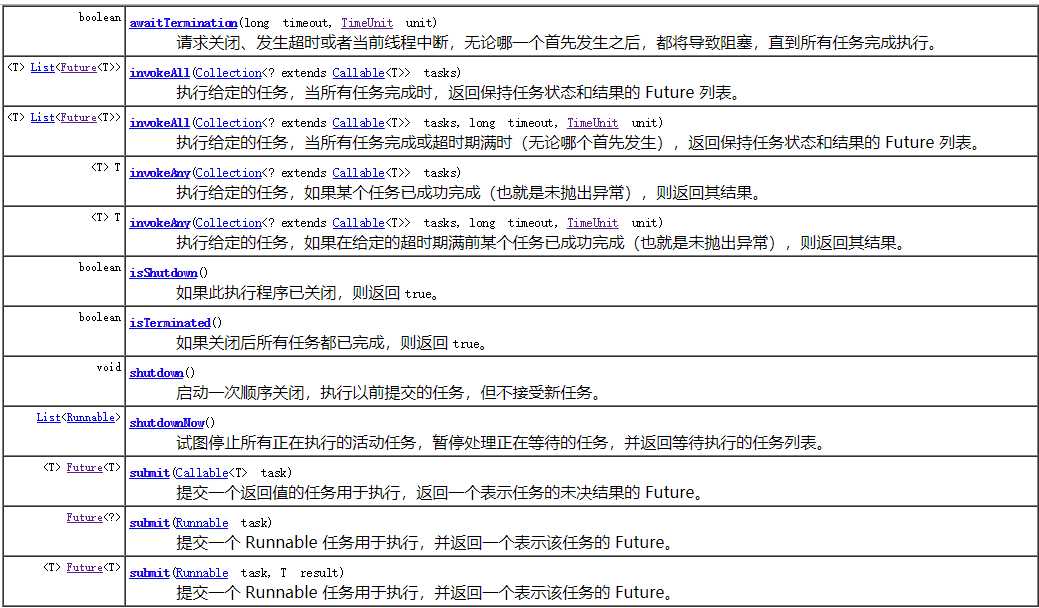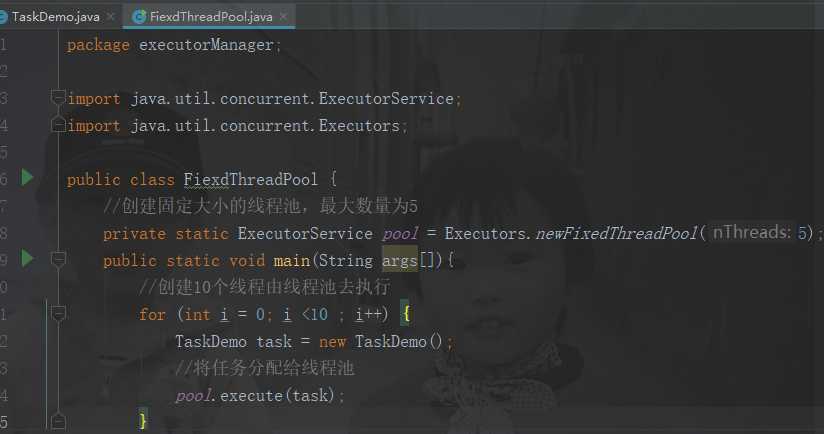标签:amp rem lap 新建 linked == ret hand tool
用优雅的方式理解和使用线程池

此包中所定义的 Executor、ExecutorService、ScheduledExecutorService、ThreadFactory 和 Callable 类的工厂和实用方法。此类支持以下各种方法:
ExecutorService 的方法。ScheduledExecutorService 的方法。ThreadFactory 的方法,它可将新创建的线程设置为已知的状态。Callable 的方法,这样可将其用于需要 Callable 的执行方法中。newFixedThreadPool(int nThreads) 
newCachedThreadPool() 
newSingleThreadExecutor() 
newScheduledThreadPool(int corePoolSize) 
public static ExecutorService newCachedThreadPool() {
return new ThreadPoolExecutor(0, Integer.MAX_VALUE,
60L, TimeUnit.SECONDS,
new SynchronousQueue<Runnable>());
}
public static ExecutorService newSingleThreadExecutor() {
return new FinalizableDelegatedExecutorService
(new ThreadPoolExecutor(1, 1,
0L, TimeUnit.MILLISECONDS,
new LinkedBlockingQueue<Runnable>()));
}
public static ExecutorService newFixedThreadPool(int nThreads) {
return new ThreadPoolExecutor(nThreads, nThreads,
0L, TimeUnit.MILLISECONDS,
new LinkedBlockingQueue<Runnable>());
}
public static ScheduledExecutorService newScheduledThreadPool(int corePoolSize) {
return new ScheduledThreadPoolExecutor(corePoolSize);
}
链接
public ScheduledThreadPoolExecutor(int corePoolSize) {
super(corePoolSize, Integer.MAX_VALUE, 0, NANOSECONDS,
new DelayedWorkQueue());
}
链接
public ThreadPoolExecutor(int corePoolSize,
int maximumPoolSize,
long keepAliveTime,
TimeUnit unit,
BlockingQueue<Runnable> workQueue) {
this(corePoolSize, maximumPoolSize, keepAliveTime, unit, workQueue,
Executors.defaultThreadFactory(), defaultHandler);
}
核心参数
int corePoolSize 核心线程池的大小
int maximumPoolSize 最大线程数量
long keepAliveTime 线程保持活动的时间 为什么这里要有保持活动时间?因为存在核心线程池,与线程池同生命周期(同生共死),非核心也就是最大线程数量超过核心线程数量的线程,会存在生命周期。
TimeUnit unit 线程保持活动的时间单位
BlockingQueue<Runnable> workQueue 任务队列(BlockingQueue:阻塞队列)
defaultHandler 拒绝策略
线程池状态:
private static final int COUNT_BITS = Integer.SIZE - 3; 线程数量状态变化
private static final int CAPACITY = (1 << COUNT_BITS) - 1; 最多容量
private static final int RUNNING = -1 << COUNT_BITS;
private static final int SHUTDOWN = 0 << COUNT_BITS;
private static final int STOP = 1 << COUNT_BITS;
private static final int TIDYING = 2 << COUNT_BITS;
private static final int TERMINATED = 3 << COUNT_BITS;

int c = ctl.get();//获取当前线程池的状态
if (workerCountOf(c) < corePoolSize) {//当前线程数量小于 coreSize 时创建一个新的线程运行
if (addWorker(command, true))
return;
c = ctl.get();
}
if (isRunning(c) && workQueue.offer(command)) {//如果当前线程处于运行状态,并且写入阻塞队列成功
int recheck = ctl.get();
if (! isRunning(recheck) && remove(command)) //双重检查,再次获取线程状态;如果线程状态变了(非运行状态)就需要从阻塞队列移除任务,并尝试判断线程是否全部执行完毕。同时执行拒绝策略。
reject(command);
else if (workerCountOf(recheck) == 0) //如果当前线程池为空就新创建一个线程并执行。
addWorker(null, false);
}
else if (!addWorker(command, false)) //如果在第三步的判断为非运行状态,尝试新建线程,如果失败则执行拒绝策略
reject(command);
}
pool.shutdown();
while(!pool.isTerminated()){
}
标签:amp rem lap 新建 linked == ret hand tool
原文地址:https://www.cnblogs.com/gnwzj/p/10631926.html